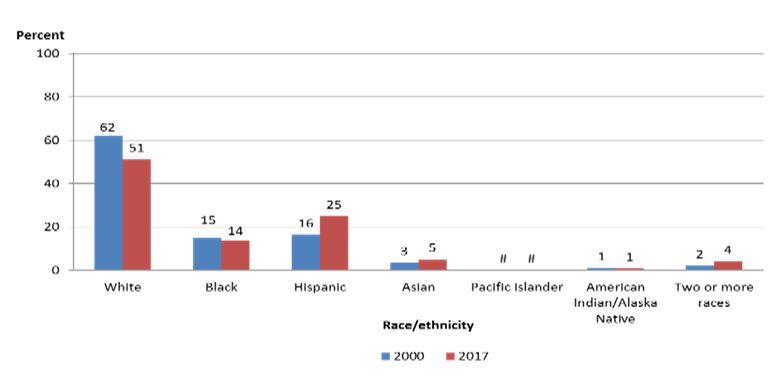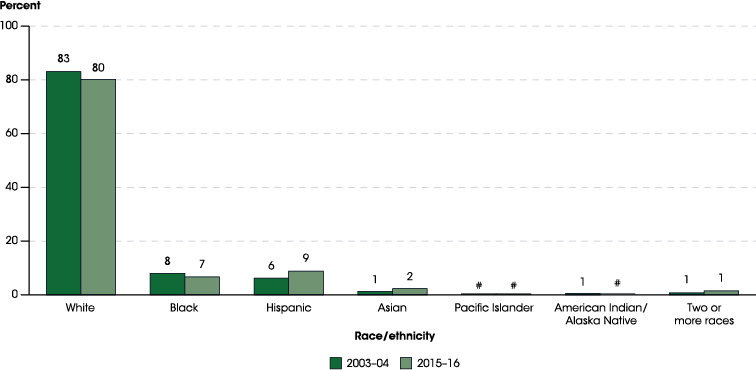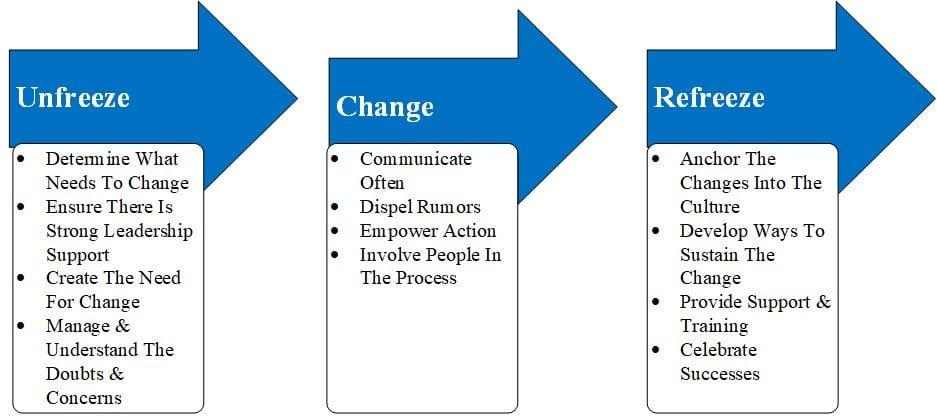Introduction
Diversity in the workplace is one of the issues that leadership of an institution should understand and effectively manage. The United States is one of the most diversified nations in the world, a fact that can be attributed to several decades of immigration (Hughes, 2019). As the American society become increasingly diversified, it is expected that education workplace will be diversified as well. According to Siu (2021), a diversified workplace environment is beneficial to the institution. It enables it to understand the varying needs of different clients. The problem is that sometimes diversity may become a divisive factor in an organization that cripples operations instead of facilitating the desired growth. When it becomes a problem instead of a benefit to a learning institution, the leadership of that school should find ways of introducing change. That change can only be sustainable if it is supported by all the stakeholders and it addresses a specific problem that is of concern to the institution. In this paper, the researcher seeks to investigate diversity in secondary education workplace, determine the ideal way to change it, and assess if the change will be sustainable
Literature Review
The concept of diversity in the workplace has attracted the attention of many scholars over the past several years. In this section of the report, it is necessary to start by providing the definition of the term. According to Griffen (2021), diversity in workplace refers to the existence of people of people from different races, gender, age, religion, sexual orientation, or any other demographical classification. In a highly diversified society such as that in the United States, it is common to have a highly diversified workplace environment. In a research, it is possible for a scholar to focus on any of the demographical classification (race, gender, religion, sexual orientation, age, or social class) when assessing the impact of diversity on the normal functioning of an institution. In this study, the researcher narrowed down to race, which remains one of the most sensitive issues in the United States. The study will assess the current state of diversity in the country and changes that should be implemented to ensure that these learning institutions are successful in achieving their mandate.
Diversity in the Secondary Education Workplace
When assessing the level of workplace diversity in secondary schools in the United States, it is necessary to start by investigating the level of diversity of clients, which are the students. The level of diversity of teachers and the non-teaching staff should reflect the diversity of students in the school. Figure 1 below shows the level of diversity in secondary schools by race over a different period. It is evident that in the year 2000, the percentage of whites in the country was 62%, but it reduced to 51% in 2017. Similarly, the population of black students was 15% in 2000 but it has since dropped to 14%. On the other hand, the percentage population of the other races are on the rise. The population of the Hispanics in the country was 16% in 2000, but it increased to 25% in 2017. The Asian population increased from 3% to 5%, while those of mixed races increased from 2% to 4% within the same period. The population of American Indians/Alaska Natives and Pacific Islanders did not change within the same period.

It is necessary to ensure that the changes witnessed in student population is reflected in the teaching and non-teaching staff in these learning institutions. Figure 2 below shows the changes in the population of teachers in public elementary and secondary school by race. In 2003-2004, white teachers represented 83% of the total population of teachers at this level of education. The number dropped to 80% in the years 2015-2016. The number of black teachers was 8% of the total population of teachers in 2003-2004 but it dropped to 7% in 2015-2016. The Hispanic teachers represented 6% of the entire population of teachers, but it increased to 9%. The population of those of Asian race increased from 1% to 2% over the same period, while those of mixed races remained unchanged within the same period. The population of American Indians or Alaska Natives has dropped, relative to the population of other races, while the number of Pacific Islanders remain negligible in the teaching industry.

The statistics above shows that there is a need for change to address the issue of diversity in the workplace. The percentage of students in secondary school should be reflected in the teaching and non-teaching staff. There is an indication that some races are not effectively represented in the teaching fraternity. For instance, the population of white students has dropped from 62% to about 50%. However, the population of white teachers remain significantly high, changing from 83% to 80%. The other remaining races are disenfranchised in terms of their representation among the teaching staff. As of 2016, the population of black teachers was established to be 7% while the population of black students was 14%. It means that the ratio is misrepresented by 50%. For the Hispanics, the population of students was established to be 25% of the entire population, while that of teachers is only 9%. The percentage of Asian teachers in 2016 was 2% while that of the students of the same race is 5%. The mixed race, Pacific Islanders, and Alaska Natives are all affected by the misrepresentation in the teaching staff.
The Needed Change
Statistics discussed above have pointed out to a major problem that needs to be addressed. The change that is needed is equal represent of teachers to reflect the actual population of students. As the American society become increasingly diversified, there is a need to ensure that the workplace environment represent the same change. Zukof (2021) argues that the problem that is often witnessed is that the diversity in the country is sometimes misrepresented because of illegal immigration. For instance, when a Hispanic family comes to the United States illegally, the child will be documented if they start going to school, but the parent will remain undocumented because of the fear of a possible deportation (Short, 2021). In such a case, even if the Hispanic had the qualifications to work as a teacher, they would prefer non-formal jobs where their illegal status will remain undetected. It explains why whites still hold a disproportionately high percentage of the teaching staff positions. They are not affected by the problem of illegal immigration as much as Hispanics and blacks are.
The Ideal Way It Should Be Changed
Introducing change in an organization can be a major challenge if it is not done in the right way. Siu (2021) suggests that there should be a systematic way of introducing change that is based on a specific method. The biggest challenge when introducing change is the resistance that can come from the stakeholders expected to support it. When some people feel that the proposed change targets them negatively, they may be opposed to it. Others may oppose change primarily because of the fear of the unknown. It is important to ensure that all these concerns are addressed to eliminate any possibility that the relevant stakeholders will oppose it. One can use various models of change management depending on the goal that should be realized and circumstances that an organization faces, as McDonald (2021) suggests. In this case, Kurt Lewin’s change model, shown in figure 3 below, was considered the most desirable. The model identifies three stages that should be followed to successfully introduce change within an organization.
Unfreeze
The first stage is to unfreeze, where all the relevant stakeholders are to be prepared for the change process. The stage starts by determining what needs to be changed in the organization. In this case, the expected change is to have racial balance among the teaching staff in the local secondary schools. Griffen (2021) explains that the need for change should be communicated in a way that does not instill fear among a section of the community. In this case, there should be a clear message that whites will not be fired from their jobs. Instead, additional teachers of other races will be hired to create the racial balance in these institutions.
There is a need to ensure that the leadership of the institutions support the proposed change. The heads of these secondary schools are expected to implement the proposed change. They can only do so if they understand its relevance and significance in facilitating growth and development (Zukof, 2021). The school administrators should understand that the diversity will enable their institutions to serve their students better. It means that any concerns that these administrators have should be addressed to ensure that they support the course.
The team should then create a need for change. It involves making everyone to understand the current weaknesses and how the proposed changes will address them. In this case, all the teachers, parents, and students should understand the benefit that the diversity will bring and the current problems that it will solve. Doubts, concerns, and unrealistic expectations should be addressed effectively at this stage. Hughes (2019) states that effective communication is essential at this stage. As the team is prepared for change, messages should be made as clear as possible and questions raised should be answered effectively.
Change
The second stage in this model is the actual introduction of change. The assumption at this stage is that the previous stage had fully prepared stakeholders for change, and that all their major concerns were effectively addressed (Griffen, 2021). The team responsible for introducing the change is expected to communicate often. In this case, change will be introduced by hiring a higher number of minorities in these school. The administrators responsible for the hiring process should inform all the other stakeholders of the planned activities, when it will start, the approach it will take, and how roles and responsibilities of the current teachers will be affected.
The stage also require the administrators to dispel rumors that may negatively affect the implementation process. For instance, there may be a rumor that the strategy is meant to eliminate or disenfranchise white teachers. Once the recruitment of additional teachers begin, such rumors should be addressed to ensure that the current teachers feel comfortable with the change. They should be reminded that the move will help lessen their workload. It will also make it possible for the teaching staff to have a better understanding of challenges affecting individual students within the institution. Unique challenges of a Pacific Islander student can be understood more effectively by a teacher who is of the same race.
When introducing the change, this model emphasizes the need to involve all the relevant stakeholders in the process. If possible, they should be actively be involved in implementing the change (Smith et al., 2020). The responsibility of hiring new teachers rests on the shoulders of the administrators of a school. However, the administration can involve the teaching staff in the process of recruitment. The teachers will be asked to stake specific areas where there are a shortage of teachers. They can also suggest the level of experience that should be prioritized when recruiting additional teachers.
Refreeze
The last stage when using this change model is to refreeze. Gallagher (2019) explains that it is at this stage where one is expected to anchor the changes made into the culture of an organization. It involves making the new environment to become a standard practice within the organization. The institutions of learning should embrace the new culture of racial diversity and equal representation. There may be a need to offer some training and support to ensure that the new policy is entrenched. The team should celebrate the change as a positive occurrence that will improve lives of all stakeholders. This stage also require the team to develop ways to sustain the change, as discussed in the next section below.

Sustainability of the Change
Achieving a sustainable change can be a major challenge when addressing a systemic problem in the society. Racial segregation and racism are major issues in the country that pose serious challenges in the workplace environment (Daim, 2019). The genesis of the problem is the American community, not the school. It is only manifested in the schools because they represent society. It means that the best way of addressing the problem would be to promote racial equality and proportionate representation in society in general. However, that is not the focus of this study. The best way of dealing with the problem is to address it at different social institutions, and school is one of them.
Sustainability can be achieved in this context if all the stakeholders understand the significance of the intended goal. As discussed in the model above, the first step of achieving sustainability in the proposed change is to fully prepare all the stakeholders for the intended change. They should feel the need for the change and specific problems that it intends to address. When they are adequately involved, they will feel that they own the change process. In such cases, they will be willing to support the change because they understand the significance of the new environment.
Sustainability can also be achieved by constantly fighting misinformation that may spread unnecessary fear among the stakeholders. According to Gallagher (2019), sometimes change is rejected after it is introduced because of rumors spread by those keen on maintaining status quo. The only way of fighting such a problem is to ensure that all the stakeholders are adequately informed about the new system. Regular reminders will also be essential to fight misinformation. The team should remain vigilant enough to understand how the new system is misrepresented. They should then focus on addressing such misrepresentations to ensure that the support for the new system is maintained.
Conclusion
Diversity in the secondary education workplace has become an issue of concern. The report shows that although major milestones have been made, there is still a race misrepresentation of the teaching staff when compared to the student population. The percentage of white teachers is disproportionately high compared with other races when the race composition of students is taken into account. As such, the proposed change was that there is a need to proportionately increase the number of teachers of the minority races in these schools. Introducing such a change can be countered by massive resistance, especially from those who feel that they are targeted. In this case, whites may feel that the proposed change is meant to deny them teaching opportunities in the country. Managing such concerns is critical in ensuring that diversity is achieved but in a way that is supported by every stakeholder.
The study suggests using Kurt Lewin’s change model that identifies three stages of change. The different stages are meant to ensure that the stakeholders are fully prepared and understand the significance of change. When followed properly, it will help in ensuring that the concentration of minority teachers is increased without causing concern among the white teachers. Constant communication and engagement with all the relevant stakeholders in the education sector will help in fighting miscommunication and enhancing sustainability of the new system.
Takeaways
The report has addressed the issue of diversity in secondary education workplace and changes that are needed to achieve equal representation in terms of race. The following are the takeaways from the research that has been conducted in this project:
- Having a diversified workplace environment is the best way of ensuring that students get the best service delivery. It helps in ensuring that unique challenges that a student face, which may be attributed to their race, can be easily understood by the teaching staff;
- The current problem of race misrepresentation is a systemic problem that requires the involvement of different stakeholders to achieve the desired goals;
- Relative to the population of students, Hispanics are the most misrepresented race in the local schools. The problem is largely caused by the fact that a significant population of Hispanics are illegal immigrants;
- Although the problem of race misrepresentation in the teaching fraternity in the country still persists, the statistics show that the population of the minorities is increasing.
References
Brey, C. (2020). New report shows increased diversity in U.S. schools, disparities in outcomes. National Center for Education Statistics. Web.
Daim, T. U. (2019). R&d management in the knowledge era: Challenges of emerging technologies. Springer.
Gallagher, P. F. (2019). Leadership of change volume 3: Change management handbook. PFG Publishing.
Geada, N., & Fernandes, A. (2021). Reviving businesses with new organizational change management strategies. Business Science Reference.
Griffen, J. (2021). Challenges to integrating diversity equity and inclusion programs in organizations. IGI Global.
Hughes, C. (2019). Workforce inter-personnel diversity: The power to influence human productivity and career development. Palgrave Macmillan.
McDonald, K. (2021). It is time to talk about race at work: Every leader’s guide to making progress on diversity equity and inclusion. John Wiley & Sons.
National Center for Education Statistics. (2019). Spotlight A: Characteristics of public school teachers by race/ethnicity. National Center for Education Statistics. Web.
Short, L. (2021). Expand beyond your current culture: Diversity and inclusion for CEOS and leadership. Maven House.
Siu, B. (2021). Opening doors to diversity in leadership. University of Toronto Press.
Smith, A., Skinner, J., & Read, D. (2020). Philosophies of organizational change: Perspectives models and theories for managing change. Edward Elgar Publishing.
Zukof, K. (2021). The hard and soft sides of change management: Tools for managing process and people. Association for Talent Development.